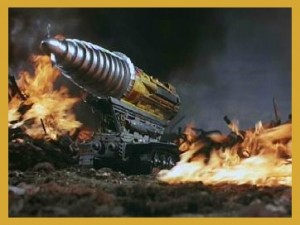The Mole

Here are the Canon Foundry facts about The Mole, all taken from the Thunderbird FAB Cross-Sections book written by Graham Bleathman (1999):
Mole Specifications
Length: 60 feet
Width: 12 feet
Weight: 12 tons
Maximum Drilling Speed: 15 m.p.h.
Power: Nuclear-fusion-powered electric motors
Trolley Specifications
Length: 38 feet
Width: 24 feet
Weight: 18 tons
Maximum Speed: 50 m.p.h.
Power: 1,000 b.h.p. high-compression dual-turbine engine
Other Information
- Carried to the rescue zone in Thunderbird 2
- One of the larger pod vehicles
- Is used to help recover victims trapped in collapsed buildings or buried underground
- Can be operated with great precision thanks to the three-dimensional thermal-imaging system built into the drill bit
- The Mole is carried to the rescue zone from its pod on a trolley and then tilted to a near-vertical position to commence drilling
- Caterpillar tracks on each side enable the Mole to return to the surface, reversing back up on to the trolley on completion of a rescue
- Contains a multiple missile launch system used for demolition
- Wide-angle TV camera enables driver to position trolley before drilling commences
- Uses hydraulic suspension (trolley)
- A hydraulic jack lifts the upper section of the trolley to the desired drilling angle
- The trolley is fueled by rocket propellant
- The trolley is controlled from the driver’s console in the Mole itself
- The Mole contains an air recycling plant and life support system
- The drill bit’s ‘propeller wings’ provide a high-speed cutting edge
- Positions of victims via the acoustic detector and 3D thermal-imaging system can be logged on the Mole’s computer and the data transferred to TB2, allowing for more delicate rescue operations using smaller drilling equipment and hand-held laser cutters
- The drill bit is constructed from Formula C30/1, a cahelium-derived alloy that can cut through virtually all known metals
- Shielded nuclear fusion reactor provides power for electric generators to operate the drill, caterpillar tracks and rear thruster
- The main computer handles all functions so that the driver can concentrate on the mission using the simplified control systems in the cabin
- The main control system controls the Mole, the trolley, video and thermal-imaging systems and doubles as a mobile rescue control unit similar to the “Mobile Control” unit carried on Thunderbird One
- There is a temperature sensor at the very top of the Mole’s hull. There are also rescue location external temperature and pressure sensors on the sides of the trolley near its back end
- Bench seating in the cabin can be folded down to provide bunk space or room for stretchers
- There is a topside exit hatch and a rear exit hatch
- A storage bay at the rear of the Mole contains medical and rescue supplies, thermal suits and laser cutters
Other Sources:
“As the Mole burrows it pumps a concrete solution through ducts in its sides to line the walls of the bore-hole.”
Source: Theydon, John (1966), Calling Thunderbirds. Titan. p. 53.

